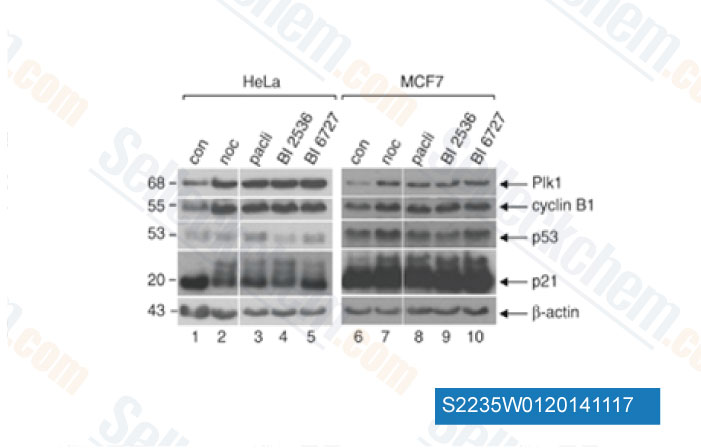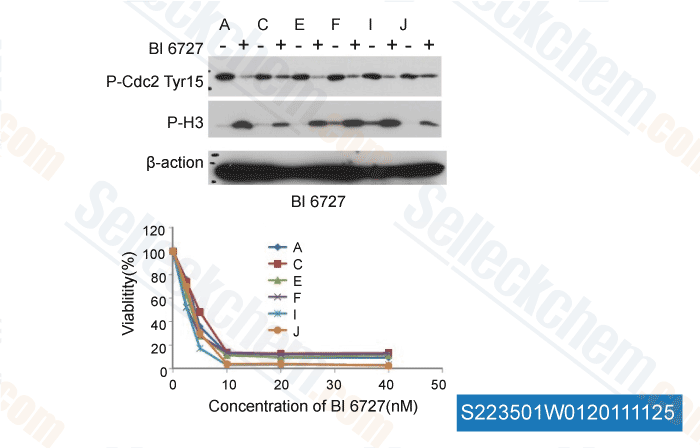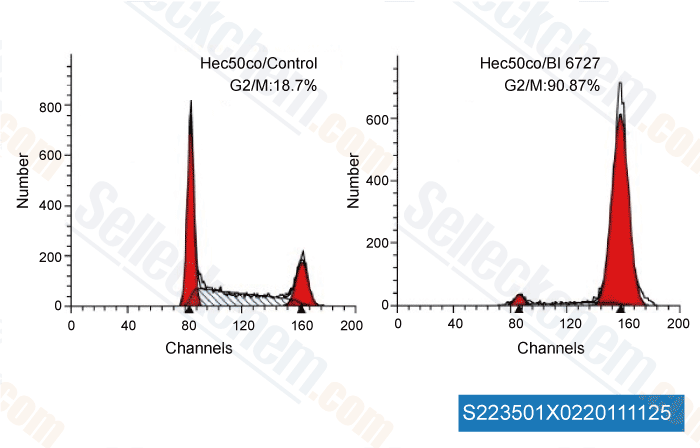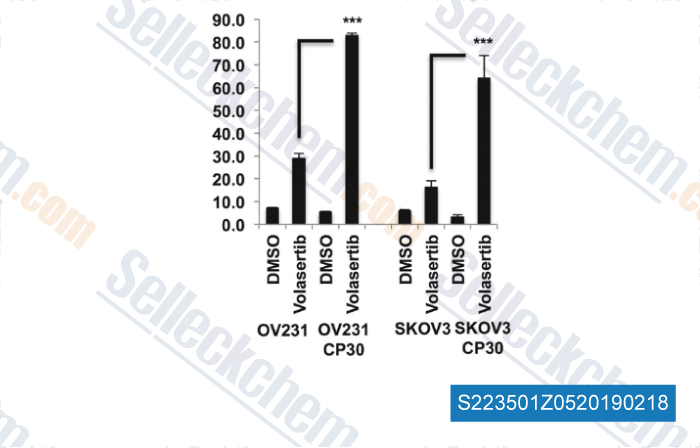|
Toll Free: (877) 796-6397 -- USA and Canada only -- |
Fax: +1-832-582-8590 Orders: +1-832-582-8158 |
Tech Support: +1-832-582-8158 Ext:3 Please provide your Order Number in the email. |
Technical Data
| Formula | C34H50N8O3 |
||||||||||
| Molecular Weight | 618.81 | CAS No. | 755038-65-4 | ||||||||
| Solubility (25°C)* | In vitro | DMSO | 20 mg/mL (32.32 mM) | ||||||||
| Water | Insoluble | ||||||||||
| Ethanol | Insoluble | ||||||||||
| In vivo (Add solvents to the product individually and in order) |
|
||||||||||
|
* <1 mg/ml means slightly soluble or insoluble. * Please note that Selleck tests the solubility of all compounds in-house, and the actual solubility may differ slightly from published values. This is normal and is due to slight batch-to-batch variations. * Room temperature shipping (Stability testing shows this product can be shipped without any cooling measures.) |
|||||||||||
Preparing Stock Solutions
Biological Activity
| Description | Volasertib is a highly potent Plk1 inhibitor with IC50 of 0.87 nM in a cell-free assay. It shows 6- and 65-fold greater selectivity against Plk2 and Plk3. Volasertib induces cell cycle arrest and apoptosis in various cancer cells. Phase 3. | ||
|---|---|---|---|
| Targets |
|
||
| In vitro | Like BI2536, BI6727 is an ATP-competitive kinase inhibitor from the dihydropteridinone class of compounds. In addition to Plk1, BI6727 also potently inhibits two closely related kinases Plk2 and Plk3 with IC50 of 5 nM and 56 nM, respectively. BI6727 at concentrations up to 10 μM displays no inhibitory activity against a panel of >50 other kinases. BI6727 inhibits the proliferation of multiple cell lines derived from various cancer tissues, including HCT116, NCI-H460, BRO, GRANTA-519, HL-60, THP-1, and Raji cells with EC50 of 23 nM, 21 nM, 11 nM, 15 nM, 32 nM, 36 nM, and 37 nM, respectively. BI6727 treatment (100 nM) in NCI-H460 cells induces an accumulation of mitotic cells with monopolar spindles and positive staining for histone H3 phosphoserine 10, confirming that cells are arrested early in the M phase, followed by induction of apoptosis. [1] Low nanomolar concentrations of BI6727 display potent inhibitory activity against neuroblastoma (NB) tumor-initiating cells (NB TIC) with EC50 of 21 nM, whereas only micromolar concentrations of BI6727 are cytotoxic for normal pediatric neural stem cells. [2] BI6727 induces growth arrest of Daoy and ONS-76 medulloblastoma cells similar to BI 2536. [3] | ||
| In vivo | Administration of BI6727 significantly inhibits the growth of multiple human carcinoma xenografts including HCT116, NCI-H460, and taxane-resistant CXB1 colon carcinoma, accompanied by an increase in the mitotic index as well as an increase in apoptosis. [1] In in vivo studies, BI6727 shows better toxicity and pharmacokinetic profile compared to BI2536. [3] | ||
| Features | A high volume of distribution, indicating good tissue penetration, and a long terminal half-life. |
Protocol (from reference)
| Kinase Assay:[1] |
|
|---|---|
| Cell Assay:[1] |
|
| Animal Study:[1] |
|
References
|
Customer Product Validation

-
Data from [Oncogene, 2013, 10.1038/onc.2013.518]

-
, , Dr. Xiangbing Meng from University of Iowa

-
Data independently produced by , , Dr. Xiangbing Meng from University of Iowa

-
Data from [Data independently produced by , , Clin Cancer Res, 2018, 24(18):4588-4601]
Selleck's Volasertib has been cited by 175 publications
| Systematic analysis of RNA-binding proteins identifies targetable therapeutic vulnerabilities in osteosarcoma [ Nat Commun, 2024, 15(1):2810] | PubMed: 38561347 |
| PLK1 and FoxM1 expressions positively correlate in papillary thyroid carcinoma and their combined inhibition results in synergistic anti-tumor effects [ Mol Oncol, 2024, 10.1002/1878-0261.13610] | PubMed: 38361222 |
| PLK1 phosphorylates RhoGDI1 and promotes cancer cell migration and invasion [ Cancer Cell Int, 2024, 24(1):73] | PubMed: 38355643 |
| Eph signal inhibition potentiates the growth-inhibitory effects of PLK1 inhibition toward cancer cells [ Eur J Pharmacol, 2024, 963:176229] | PubMed: 38072041 |
| Multidimensional screening of pancreatic cancer spheroids reveals vulnerabilities in mitotic and cell-matrix adhesion signaling that associate with metastatic progression and decreased patient survival [ Biochem Biophys Res Commun, 2024, 703:149575] | PubMed: 38382357 |
| Polθ is phosphorylated by PLK1 to repair double-strand breaks in mitosis [ Nature, 2023, 621(7978):415-422] | PubMed: 37674080 |
| Master mitotic kinases regulate viral genome delivery during papillomavirus cell entry [ Nat Commun, 2023, 14(1):355] | PubMed: 36683055 |
| Molecular landscape and functional characterization of centrosome amplification in ovarian cancer [ Nat Commun, 2023, 14(1):6505] | PubMed: 37845213 |
| Multiplexed kinase interactome profiling quantifies cellular network activity and plasticity [ Mol Cell, 2023, 83(5):803-818.e8] | PubMed: 36736316 |
| PLK1 inhibition dampens NLRP3 inflammasome-elicited response in inflammatory disease models [ J Clin Invest, 2023, 133(21)e162129] | PubMed: 37698938 |
RETURN POLICY
Selleck Chemical’s Unconditional Return Policy ensures a smooth online shopping experience for our customers. If you are in any way unsatisfied with your purchase, you may return any item(s) within 7 days of receiving it. In the event of product quality issues, either protocol related or product related problems, you may return any item(s) within 365 days from the original purchase date. Please follow the instructions below when returning products.
SHIPPING AND STORAGE
Selleck products are transported at room temperature. If you receive the product at room temperature, please rest assured, the Selleck Quality Inspection Department has conducted experiments to verify that the normal temperature placement of one month will not affect the biological activity of powder products. After collecting, please store the product according to the requirements described in the datasheet. Most Selleck products are stable under the recommended conditions.
NOT FOR HUMAN, VETERINARY DIAGNOSTIC OR THERAPEUTIC USE.
